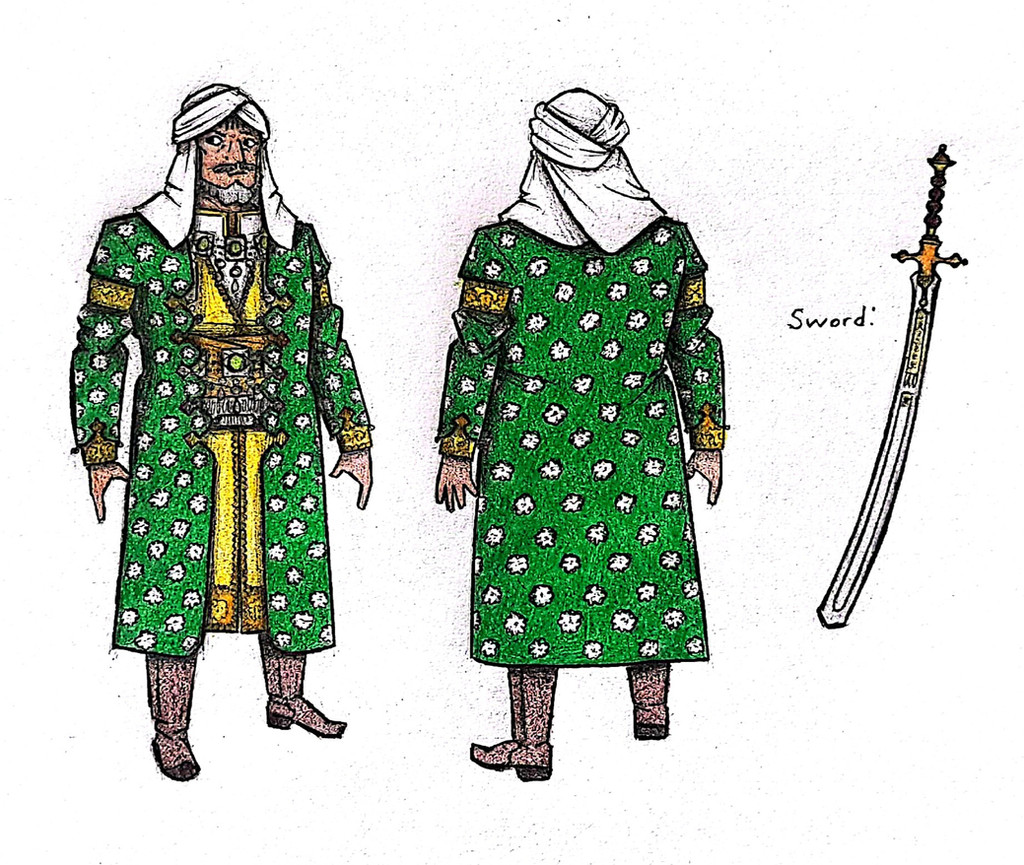HOME | DD
 Avapithecus — Majd ad-Din al-Mubarak ibn Munkid
Avapithecus — Majd ad-Din al-Mubarak ibn Munkid

#arabic #character #crusades #design #history #medieval #referencesheet #ayyubid
Published: 2024-03-02 19:46:21 +0000 UTC; Views: 4462; Favourites: 35; Downloads: 0
Redirect to original
Description
Ignore me- I'm just gonna delete then re-upload these three sheets because the description glitch is driving me absolutely bonkers and since DA tech support ain't gonna do anything, this seems to be the best fix.Okay hold my beer. I knew off the bat when I set out to draw all the historical characters in Assassin's Creed that pretty much all of the Muslim targets in the first game were fictional. Tamir, Talal, Abu'l Nuqoud, and Jubair ibn Hakim have no historical counterparts like the Crusaders do, or at least none that I could dig up after many hours of scrounging the internet. Majd Addin, however, might be the one exception. I say “might” because “Majd ad-Din” is a fairly common Arabic name which just means “Glory of the Faith”, and to make my life needlessly complicated, there were quite a few dudes running around Ayyubid territory sporting this name during the game's time period. The game itself doesn't exactly provide many context clues about which of these men, if any, it's trying to portray. However, after inputting many alternate spellings and scrambled keywords into Google Books, I think I've actually narrowed down the best candidate, so I've decided to include him in this project. I'm extracting this information from an 1843 translation by William McGuckin de Slane of Ibn Khallikan's biographical dictionary. There's not exactly a lot written here to misconstrue, but if anything turns out to be inaccurate, you know which crusty old white guy to blame.
I introduce Abû ‘l-Maimùn al-Mubàrak Ibn Kàmil Ibn Ali Ibn Mukallad Ibn Nasr Ibn Munkid al-Kinàni, surnamed Saif ad-Dawlat Majd ad-Din because it wasn't a mouthful already. This Majd ad-Din was born in 1131 or 1132 in the castle at Shaizar in what is today Syria. He was the grandson of the emir Sadid al-Mulk, and cousin of the poet Usama ibn Mundiqh, so right from the get-go today's protagonist had a nice shiny silver spoon to put on his job applications. In May 1174, a niche was carved out for him when Saladin's brother, Turan-Shah, invaded Yemen and plopped Majd ad-Din down as administrator over the town of Zabid. It was a pretty sweet gig, but Majd ad-Din was a busy guy with like… plans and a life and stuff, so he got permission to delegate the job to his brother Hattàn while he was away in Egypt. All well and good, until Turan-Shah died in 1180 and Hattàn was outed for financial fraud. Majd ad-Din was himself accused of illegally seizing property and executing men in Zabid, so Saladin threw him in prison in 1181. Saif al-Islàm Toghtikin was sent to Yemen to deal with Hattàn, who had retreated to a fortress where his ridiculous piles of Yemeni gold would totally protect him. Uh no, no it didn't. The walls were breached, seventy chests of dirty money were confiscated, and Hattàn was thrown in a dungeon, at which point he was never heard from again.
Majd ad-Din, meanwhile, was released from prison due to a lack of evidence, and he just sort of went right back to living that perfect rich asshole life. He was a lover of poetry, hosting an Ibn az-Zawari in his court to jerk off his ego, and even composing a poem himself about how much he hates fleas. Alright I joke but honestly the snippet Ibn Khallikan gives is actually pretty deep, like Majd ad-Din reflects on how when you smash a flea that's been biting you, the blood that comes out isn't the flea’s but your own. Now there's a nugget that'll keep a pothead occupied for hours. Ultimately, our Majd ad-Din ended his cushy life in Cairo, in September 1193. His hype man Ibn az-Zawari wrote the eulogy, proclaiming that the man was “smoother, in peace than the belly of a serpent” and “rougher, in war, than the back of a porcupine.” I meanwhile expect my eulogy to be something along the lines of “ha ur ded, get fukt bich.”
Design notes, I mostly just winged it on this one. I mean the man who has all of three paragraphs to his name in the entire historical record, so I decided simplicity was for the best. Ibn Khallikan does cite a descriptive Ibn az-Zawari poem, but it's all about Majd ad-Din's supposedly beautiful facial features, like how he's got ruby lips and teeth like moist pearls (his words not mine). He's also described as having a cheek line of emerald, which McGuckin attempts to compare to how myrtle is used in English poetry… and then fails to elaborate on that. I'm sure it would've made perfect sense to an 1843 audience, but I couldn't find any references online for what myrtle symbolized to your average Victorian outside generic themes of love. Whatever, what I do know is that myrtle is a flower and flowers make for great textiles. I tried to look up specific examples of myrtle motifs used in Arabic fabrics, but came up short. Instead the most colorful results on Google Images are the carpet of an Islamic center at Myrtle Beach and the cover of a book called In the Garden of Myrtles. At this point I just kinda said ehhhh fuck it and took some minor inspiration from these two sources.
Now his sword, meanwhile, I had a lot of fun with. Taking some inspiration from the accusations of wrongful executions (and admittedly some bias from the Majd Addin in Assassin's Creed), I wanted to give him an executioner’s sword. Unfortunately, typing “Arabic executioner's sword” into Google Images gives you some… disturbingly modern results, so I had go veer a little eastward into India to get my inspiration. European executioner's swords are blunt at the top and designed for maximum chopping force, because there's a surprising amount of specialization required to lob a man's head off. Middle Eastern swords meanwhile seem to achieve this same effect by just making the blade as wide as your mom. While interesting, they look a little awkward (I know, how dare they not think of the aesthetics for a blade whose sole purpose is to chop heads off-), so instead I tried to find the middle ground between these two designs. I'm honestly quite pleased with how it turned out. Curved blades can often be very hit or miss to draw by hand, and I think this one was a hit. Always very satisfactory. Not for the guy getting beheaded, but he's dead so fuck him anyway.
Related content
Comments: 4

👍: 0 ⏩: 1

👍: 0 ⏩: 1

👍: 0 ⏩: 1

👍: 1 ⏩: 0

























